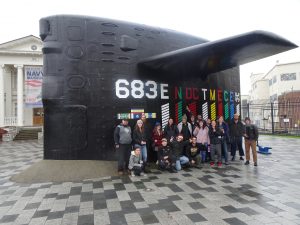
Harry Halsted
The Puget Sound Naval Shipyard (PSNS), in Bremerton, Washington, is one of the largest naval shipyards on earth, and one of the only in the U.S. dealing with nuclear- powered vessels. The 650-acre PSNS, also known as Naval Base Kitsap (NBK)-Bremerton, is 15 miles west of Seattle. The PSNS is responsible for “overhaul, maintenance, modernization, repair, docking and decommissioning of ships and submarines, and technical and logistics support.” It also the largest employer in Kitsap County, employing 1,652 (McClary 2003).
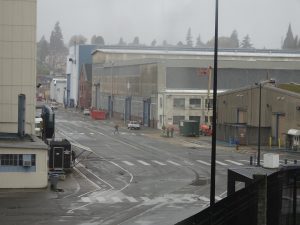
History of the Shipyard
In 1877, Congress backed the idea of building a naval shipyard in the Pacific Northwest. The reason behind this proposal was because “the United States had no repair facilities north of San Francisco’s Mare Island Navy Ship Yard large enough to accommodate military and commercial steamers and sailing vessels” (McClary 2003) The PSNS was constructed in the City of Bremerton, on the Sinclair Inlet of Kitsap County, in 1891. PSNS was the first naval dry-dock and repair facility in the Pacific Northwest.
Navy Lieutenant Ambrose Barkley Wyckoff surveyed the upper Puget Sound and found that “the area had good harbors, a mild climate, and access to plenty of timber, iron ore, and coal.” Due to Wyckoff, in 1888 Congress created a commission of “three competent Naval Officers” to find a site suitable for a naval shipyard and dry dock for the Pacific Northwest. In March 1891, “Congress appropriated $10,000, which was $15,000 less than the Navy requested, to acquire 200 acres of land for the shipyard and dry-dock facility”(McClary 2003).
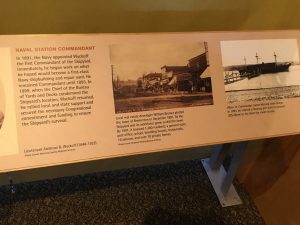
In December 1892, construction began by the Byron, Warlow and Company of Tacoma for $491,465. Dry Dock 1 was completed in 1896, and was 650 feet long, 130 feet wide, and 39 feet deep. During World War I, the shipyard took on more responsibility for shipbuilding rather than just repair. Between 1933 and 1935, “the Navy built a 1.5 million dollar machine shop.” By 1939, the shipyard employed more than 6,000 workers (McClary 2003).
During the Great Depression of the 1930s, the shipyard went through a period of expansio to build up the U.S. fleet. By 1940, the Shipyard became the main naval base on the West Coast able to handle aircraft carriers and battleships. As war was coming with Japan the shipyard’s function changed from shipbuilding to more vessel repair and overhaul. During World War II the “primary mission of Navy Yard Puget Sound was the repair of Pacific Fleet warships damaged in battle.” During the war, the Shipyard was busy having repairing “26 battleships, 18 aircraft carriers, 13 cruisers, and 79 destroyers. In addition the 30,000-plus shipyard workers built 53 new vessels, including five aircraft carriers, 13 destroyers and eight destroyer escorts, and they overhauled, repaired, or fitted out another 400 warships (McClary 2003).
During World War II, employees were working 24-hour days, and would be ferried from Seattle to Bremerton on 35 ferry trips a day. By 1945, the workforce had enlarged to 32,500. By the end of the war the PSNS changed from repair to deactivation of most of the Pacific Fleet vessels. Many of the ships disarmed were sold as scrap metal. The Shipyard also moved to modernizing aircraft carriers as one of its main jobs. By the end of 1946, “there was fewer than 9,000 shipyard employees, working mainly on ship deactivation and routine overhauls” (McClary 2003).
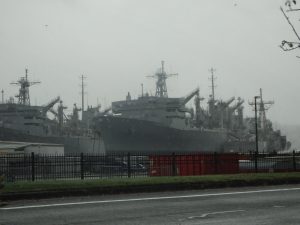
After World War II the shipyard was rather quiet until the start of the Korean War in 1950, when the PSNS focused on the constructing landing ships. Again the workforce increased “from 7,800 in 1950 to 15,300 in June 1952”(McClary 2003). By the end of the war again the job of the shipyard changed to ship deactivation. One significant ship that was deactivated, the U.S.S. Missouri which “served as the formal stage for Japan’s surrender to the Allied Powers on September 2, 1945 ending World War II” (McClary 2003).

During the Cold War, naval technologies were changing, and PSNS became a major new cog in the war machine. Between “1948 and 1962, Puget Sound Naval Shipyard concerted nine aircraft carriers to a modern configuration with angled flight decks for the new faster and heavier jet aircraft” (McClary 2003).

In 1961, the PSNS mission changed completely by being “designated as a repair facility for submarines. In 1965, the shipyard was established as a nuclear capable repair facility” (McClary 2003). In “March 1973, the nuclear repair facility was completed. Now the emphasis of shipyard was on submarines and nuclear powered ships” (McClary 2003). As the Navy’s first aircraft carrier powered by nuclear energy, the U.S.S. Enterprise was “overhauled in Dry-dock No.6 from August 1973 to February 1974 and again from January 1979 to February 1982” (McClary 2003).
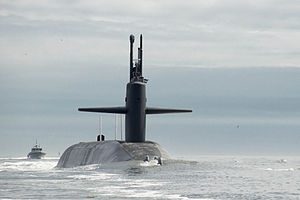
During the 1980s-90s the PSNS mission shifted more heavily toward nuclear submarine overhauls. By the 1990s, the Shipyard found methods of deactivating and recycling nuclear-powered ships (Horn 2000).

In its Submarine Recycling Program, by 2002, “approximately 20 percent of the shipyard’s workload involved deactivation, reactor compartment disposal, and ship recycling” (McClary 2003). In a way this shipyard was the Navy’s pride and joy, being “awarded the Commander-in Chief’s Installation Excellence Award in 1991 and in 1995, as the Navy’s best shipyard.” The Navy also designated PSNS as an “environmentally conscious” shipyard (McClary 2003).
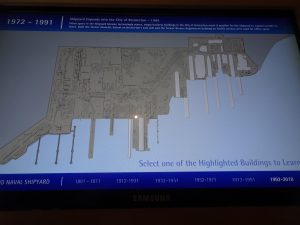
Worker Health and Safety
In 2018, KING 5 investigated claims by Puget Sound Naval Shipyard workers that they had fallen ill due to toxic chemicals in the workplace, including chlorine gas, cyanide, and acid alkaline.
The series found that for seven years “workers were exposed to the toxic agents in a wastewater treatment facility that was built without planned safety features. And many that were installed did not work” (Frame 2018).
Reporter Susannah Frame had discovered that “pipes that routinely leaked the potentially lethal agents, faulty cyanide and chlorine gas alarms, an automated chemical injection system that didn’t operate, an inadequate ventilation system, and chemical holding tanks installed without protective lids designed to keep workers safe from chemical gasses” (Frame 2018).
Many workers stated that they had developed some sort of respiratory problems. Shipyard workers were also surprised to find out that the wastewater treatment plant near the Shipyard had problems since it opened in 2006. It was closed in 2013 in a $2 million repair for safety improvements.
Some workers were interviewed about their workplace health issues. “I seem to have the same problems,” said retired supervisor Rick Montgomery of Shelton. “My breathing is getting worse all the time. I can’t even wash the car without bending over with my hands on my knees and gasping for air.” Another worker stated that “I have asthma. I didn’t have it (before). My skin welts up and turns red. I was constantly getting headaches and many skin problems. I ended up in the hospital” (Frame 2018).
Many other workers have felt the pain of worse health since starting to work at the shipyard. “My health is bad. I have severe asthma. I’m in my 30s. I was a hiker. And now I can’t walk up a flight of stairs,” said another worker.
KING 5 investigated whether the health effects here due to the proximity to the wastewater treatment plant. It found that Navy documents show that metal plating shop has its own problems. The investigation found that the “tanks in the metal plating shop overflowed and created flooding. In some circumstances, this would lead to chemicals mixing together that should never come into contact” (Frame 2018).

Environmental Impacts
The U.S. Environmental Protection Agency (EPA) has focused in on cleanup activities at the Bremerton Shipyard. According to the EPA, PSNS acknowledges that there are negative effects of the shipyard operations on the environment. These activities “generate large amounts of hazardous waste that have impacted soil, groundwater and marine sediment with petroleum hydrocarbons, heavy metals, volatile organic compounds (VOCs), semi-volatile organic compounds (SVOCs) and polychlorinated biphenyls (PCBs)” (USEPA 2018).
The Navy has prepared a “third Five-Year Review in 2012 and an addendum to that review in 2016”. The fourth Five-Year Review was concluded in 2017. When the Navy stated that “exposure pathways that could result in health risks are being controlled”(USEPA 2018).
In February 2017 the EPA completed a Supplemental Mercury Investigation Report which had been completed for the Operable Unit B Marine. The Navy “undertook this data gathering and synthesis effort following a Navy evaluation that concluded that subsistence-level consumption of Sinclair Inlet marine species poses sufficient human health risk to justify consideration of additional remedial action for mercury contamination”(USEPA 2018).
Cleanup Progress
According the EPA, the Navy has separated the site into six projects called Operable Units (OUs):
- “OU NSC addresses a 28-acre area of the site designated as the Fleet and Industrial Supply Center.”
- “OU A, which includes Charleston Beach, addresses an area at the western boundary of the site.”
- “OU B Marine addresses the marine sediment portion of the site. OU B Terrestrial addresses the upland area of the site.”
- “OU C addressed petroleum contamination and cleanup overseen by the Washington Department of Ecology (Ecology MTCA).”
- “OU D addresses 2.5 acres of land in the far eastern portion of OU B Terrestrial, which was cleaned up and transferred to the City of Bremerton for use as a park” (USEPA 2018).
But the oversight of these OUs is given to the Washington Department of Ecology, except for the OU B which is jointly led by Ecology and the EPA.
Sewage Spill into Puget Sound
KING 5 reported in August 2018 that a blocked sewer line at PSNS resulted in 80,000 gallons of wastewater “spilling into Sinclair inlet” (Stanford 2018). According to the Navy the spill was noticed on August 10. Stating that there were reports of “sewage-like” odor near the stormwater outfall of Sinclair Inlet and near the Navy Exchange at NBK-Bremerton, when the Navy was informed of the spill, the “Navy public works technicians determined a blockage in one of the main sewer lines had redirected wastewater into a stormwater vault that overflowed into the outfall near Puget Sound Naval Shipyard” (Stanford 2018).
The Kitsap Public Health District (KPHD) was notified four days after the Navy identified the issue. The KKPHD stated that “Health officials estimate wastewater had been spilling into Sinclair Inlet since July 30”. Due to the contamination of the Inlet, the KPHD posted a health notice and issued a “week-long no-contact advisory through August 21 for the waters of Sinclair Inlet and the head of the Port Washington Narrows” (Stanford 2018).
John Keiss, environmental health director for Kitsap Public Health District, urged residents to wash their eyes immediately after swimming in water and to keep good hygiene afterwards to protect themselves from the dangerous bacteria still left from the spill. At the end of the investigation the KPHD found that the source of the spill was the Naval Base Kitsap-Bremerton (Stanford 2018).
Conclusion
The Puget Sound Naval Shipyard has a great history, not only because of its large scale and the key role it has played in U.S. wars overseas, but because it is the only naval shipyard able to break apart nuclear ships and submarines. Having such a unique history, the PSNS also has a responsibility to safeguard the health and safety of workers who manufacture the weapons systems, and to protect the environment of the Bremerton community that hosts the facility. At the same time as recognizing the central role of PSNS in Kitsap County’s economy, it is important to call out any wrongdoing by the shipyard as an employer and neighbor.
Sources
Frame, Susannah. (2017, December 7). Naval shipyard managers involved in ‘cover-up’ of employee poisoning. KING 5.
Frame, Susannah. (2018, February 14). More Bremerton Shipyard Workers Blame Cyanide, Other Toxins for Illnesses. KING.
Horn, Richard. (2000, April 8). PSNS: Where submarines go when they die. Kitsap Sun.
McClary, Daryl C. (2003, November 4). Puget Sound Naval Shipyard. HistoryLink.
Naval Sea Systems Command. (n.d.). Puget Sound Naval Shipyard & Intermediate Maintenance Facility. Navsea.navy.mil.
Puget Sound Navy Museum. (2019). History.
Shipyardworker, Joe. (2018, May 31). PSNS & IMF: A Legacy of Service. YouTube.
Stanford, Julianne. (2018, June 6). Puget Sound Naval Shipyard loses workplace health and safety program ‘star site’ recognition. Kitsap Sun.
Stanford, Julianne. (2018, August 15). 80,000 Gallons of Sewage Spills into Puget Sound’s Sinclair Inlet. KING.
U.S. Environmental Protection Agency. (2017, October 20). Puget Sound Naval Shipyard Complex Site Profile. USEPA.
